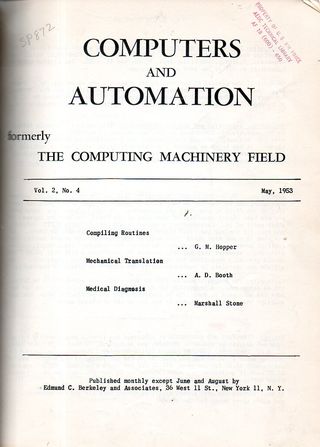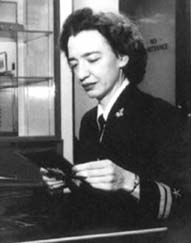JF Ptak Science Books Post 2305
 Grace Murray Hopper. "Compiling Routines", in Computers and Automation, volume 2, no.4, May 1953. 11x8 inches, ii + 33pp. The Hopper article occupies pp 1-5. Also in this issue, keeping Hopper good company: A.D. Booth "Machine Translation" and Marshall Stone, "Medical Diagnosis", plus a Who's Who in Computers (A-D) and section 2 (C,D,E) of the first edition of the computer glossary.
Grace Murray Hopper. "Compiling Routines", in Computers and Automation, volume 2, no.4, May 1953. 11x8 inches, ii + 33pp. The Hopper article occupies pp 1-5. Also in this issue, keeping Hopper good company: A.D. Booth "Machine Translation" and Marshall Stone, "Medical Diagnosis", plus a Who's Who in Computers (A-D) and section 2 (C,D,E) of the first edition of the computer glossary.
It was in the article "Compiling Routines" that the pioneer and visionary Grace Murray Hooper (1906-1992, and at last, Admiral Hopper) laid out the foundations of compiling (which is a program that translates a program written in a high-level language into another language, usually machine language). Vassar '28 and Princeton Ph.D. '34, she worked at the Harvard Computation Lab on the Mark I, II, and III, and then seemed to be at a high level just about everywhere else.
 [Image source: National Women's History Museum, here.]
[Image source: National Women's History Museum, here.]
The following from Paul Ceruzzi, A History of Modern Computing, page 367:
 Computers and Automation, the brainchild of the brainy not-child Edmund Berkeley, was the first popularly-published magazine published regarding the computer, its applications, it programming, and really just about everything else. (It appeared seven years after the Mathematical Tables and Aids to Computation was published in 1943, almost entirely to the mathematics and engineering communities.) Computers was published by Edmund Berkeley & Associates in NYC beginning in 1952., beginning its publishing journey as The Computing Machinery Field, its name changing toComputers and Automation in February 1953 (in volume 2, number 2). All issues have some fair space devoted to advertising, even though the issues generally ran between 32 and 40pp. Berkeley was a real-enough mathematician, engineer and computer pioneer, but he also had a pretty large taste for making these interests pay–which was essential, as the original print runs were not very large, though his advertisers were impressive. (According to the first issue, approximately 1200 people were on the mailing list for the journal, with around 2000 issues being printed each number. All told, this is not a large print run, and thus not many of the early issues have survived.) He was not averse to being somewhat outre with his journal—in addition to having contributors like Grace Hopper and Alton Householder, he also had Fletcher Pratt and Isaac Asimov writing some pretty arresting pieces from the SciFi/Futurama point of view.
Computers and Automation, the brainchild of the brainy not-child Edmund Berkeley, was the first popularly-published magazine published regarding the computer, its applications, it programming, and really just about everything else. (It appeared seven years after the Mathematical Tables and Aids to Computation was published in 1943, almost entirely to the mathematics and engineering communities.) Computers was published by Edmund Berkeley & Associates in NYC beginning in 1952., beginning its publishing journey as The Computing Machinery Field, its name changing toComputers and Automation in February 1953 (in volume 2, number 2). All issues have some fair space devoted to advertising, even though the issues generally ran between 32 and 40pp. Berkeley was a real-enough mathematician, engineer and computer pioneer, but he also had a pretty large taste for making these interests pay–which was essential, as the original print runs were not very large, though his advertisers were impressive. (According to the first issue, approximately 1200 people were on the mailing list for the journal, with around 2000 issues being printed each number. All told, this is not a large print run, and thus not many of the early issues have survived.) He was not averse to being somewhat outre with his journal—in addition to having contributors like Grace Hopper and Alton Householder, he also had Fletcher Pratt and Isaac Asimov writing some pretty arresting pieces from the SciFi/Futurama point of view.



Comments